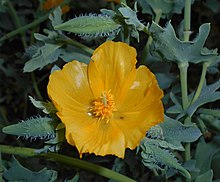Glaucium flavum
| Yellow hornpoppy | |
|---|---|
 |
|
| Scientific classification | |
| Kingdom: | Plantae |
| (unranked): | Angiosperms |
| (unranked): | Eudicots |
| Order: | Ranunculales |
| Family: | Papaveraceae |
| Genus: | Glaucium |
| Species: | G. flavum |
| Binomial name | |
|
Glaucium flavum Crantz |
|
Glaucium flavum (yellow hornpoppy or yellow horned poppy) is a summer flowering plant in the Papaveraceae family, which is native to Northern Africa, Macronesia, temperate zones in Western Asia and the Caucasus, as well as Europe. Habitat: the plant grows on the seashore and is never found inland. All parts of the plant, including the seeds, are toxic and can produce a range of symptoms up to and including respiratory failure resulting in death FDA poisonous plants database. It is a noxious weed in some areas of North America, where it is an introduced species. The thick, leathery deeply segmented, wavy, bluish-grey leaves are coated in a layer of water retaining wax. The sepal, petals and stamen have a similar structure and form to the Red Poppy (Papaver rhoeas) except the sepals are not hairy. Prolific quantities of seeds are held in a distinctive horn shaped fruit some 15 to 30 cm in length, which is divided into two chambers.
A poppy grows upon the shore,
Her leaves are glaucus-green and hoar,
She has no lovers like the red,
Her blossoms on the waves are shed,
Glaucine is the main alkaloid component in Glaucium flavum.Glaucine has bronchodilator and antiinflammatory effects, acting as a PDE4 inhibitor and calcium channel blocker, and is used medically as an antitussive in some countries. Glaucine may produce side effects such as sedation, fatigue, and a hallucinogenic effect characterised by colourful visual images, and as a recreational drug. For a detailed bibliography on Glaucine and Glaucium flavum see: National Agricultural Library (Glaucium flavum entry)
...
Wikipedia
